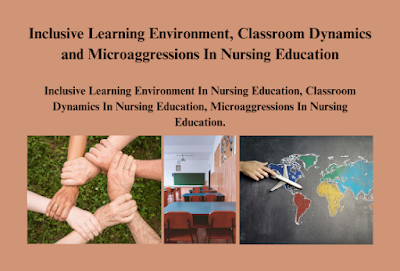The Inclusive Learning Environment Classroom Dynamics and Microaggressions In Nursing Education. Valuing individual strengths and contributions enriches the learning environment and promotes a more diverse and equitable learning experience for all.
The Inclusive Learning Environment Classroom Dynamics and Microaggressions In Nursing Education
Inclusive learning environments create accessible, welcoming, and collaborative learning spaces that are suitable for all students. In every classroom, inclusivity means acceptance and inclusion of all students. Understanding and considering differences in performance.
Anticipating, valuing, and supporting student diversity and differences: Welcoming, supportive, respectful, and safe learning environments create a sense of belonging for all students and their families.
Inclusive teaching is essential to providing all students with an optimal learning experience.
Dynamics and Microaggressions In Nursing Education An inclusive learning environment in nursing education is essential for fostering academic excellence and mutual respect. By adopting an “inclusive excellence” framework, educators can transform traditional power dynamics into a collaborative space where every student’s perspective is valued. This approach acknowledges that students come from diverse backgrounds and their unique experiences enrich the learning process (Bleich, Mac Williams, & Schmidt, 2014; Pederson Clayton & Pederson Clayton, 2008).
What Makes a Learning Environment Inclusive?
Inclusive learning environments prioritize thoughtfulness, respect, and academic rigor. In such settings, both faculty and students work together to ensure that everyone feels safe, supported, and encouraged to share their viewpoints. Content delivery is tailored to minimize marginalization and help students recognize how their individual experiences and perspectives shape their understanding of the subject matter.
The Role of Faculty in Fostering Inclusivity
Creating an inclusive environment requires the collective effort of all members of the academic community. Faculty must be proactive in managing classroom dynamics, ensuring messages of belonging and safety are communicated effectively. Admission of diverse student populations impacts the overall learning atmosphere, social environment, and recruitment strategies, making it crucial for schools of nursing to implement interventions that support all students.
Key Strategies for an Inclusive Learning Environment:
- Promote Mutual Respect: Encourage open dialogue and diverse viewpoints.
- Understand Student Backgrounds: Recognize how personal experiences influence learning.
- Foster a Safe Space: Create an environment where all students feel comfortable expressing themselves.
Navigating Classroom Dynamics in Nursing Education
Classroom dynamics play a pivotal role in student engagement and learning. For minority students, fear of rejection can hinder participation and academic performance. Faculty must be aware of the diverse backgrounds of their students and how these backgrounds affect their interactions and response patterns.
Understanding Socioeconomic Influences
Payne’s book, A Framework for Understanding Poverty (2005), provides insight into the hidden rules and behaviors associated with different socioeconomic classes. Students from varying economic backgrounds may exhibit different behaviors in the classroom, influenced by their experiences of poverty, middle-class values, or wealth-based expectations. By understanding these dynamics, faculty can design classroom strategies that bridge these gaps and create a more inclusive learning environment.
Strategies for Effective Classroom Management
- Create a Welcoming Atmosphere: Establish a classroom environment where all students feel valued from the outset.
- Adopt a Caring Pedagogy: Be flexible and understanding of different student behaviors.
- Focus on Student-Centered Learning: Adapt teaching methods to meet the diverse needs of students.
Addressing Microaggressions in Nursing Education
Microaggressions are subtle, often unintentional, forms of discrimination that can undermine the learning experience for students of color and other marginalized groups. Sue and colleagues (2007) define microaggressions as brief, commonplace indignities that communicate negative slights toward people of color and other marginalized individuals.
Impact of Microaggressions
Microaggressions can significantly affect students’ self-confidence and academic productivity (Mays, 2009). It is crucial for educators to be aware of their language and behavior to prevent these negative interactions.
Managing Microaggressions in the Classroom:
- Open Dialogue: Address microaggressions openly and explore the feelings involved.
- Monitor Reactions: Pay attention to body language and signs of disengagement from students.
- Apologize and Educate: Acknowledge mistakes and use them as learning opportunities for the entire class.
- Promote Awareness: Discuss the potential for unintentional microaggressions and educate all members of the academic community.
Effective Strategies for Addressing Microaggressions
- Acknowledge and Validate: Recognize and validate the feelings of those affected.
- Differentiate Intent from Impact: Help individuals understand the difference between their intentions and the impact of their actions.
- Encourage Courageous Dialogue: Support open conversations and express appreciation for those who engage in difficult discussions.
By fostering an inclusive learning environment, effectively managing classroom dynamics, and addressing microaggressions, nursing educators can create a more equitable and supportive educational experience for all students.
Read More:
https://nurseseducator.com/didactic-and-dialectic-teaching-rationale-for-team-based-learning/
https://nurseseducator.com/high-fidelity-simulation-use-in-nursing-education/
First NCLEX Exam Center In Pakistan From Lahore (Mall of Lahore) to the Global Nursing
Categories of Journals: W, X, Y and Z Category Journal In Nursing Education
AI in Healthcare Content Creation: A Double-Edged Sword and Scary
Social Links:
https://www.facebook.com/nurseseducator/
https://www.instagram.com/nurseseducator/
https://www.pinterest.com/NursesEducator/
https://www.linkedin.com/in/nurseseducator/
https://www.researchgate.net/profile/Afza-Lal-Din
https://scholar.google.com/citations?hl=en&user=F0XY9vQAAAAJ
